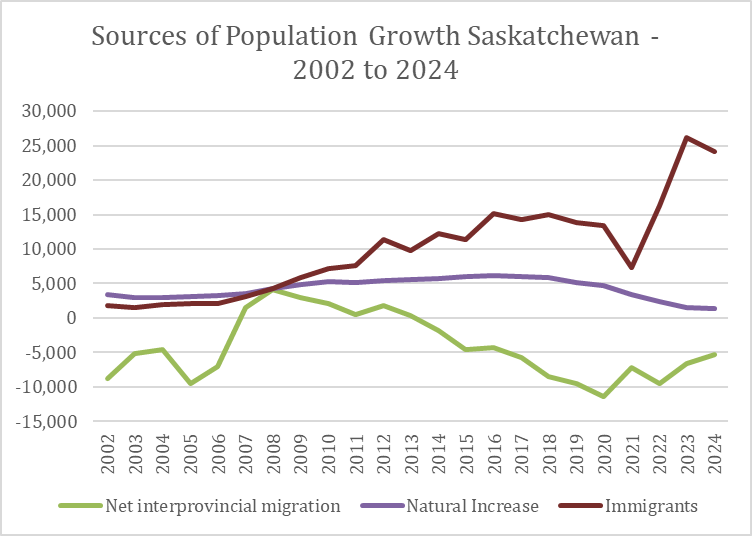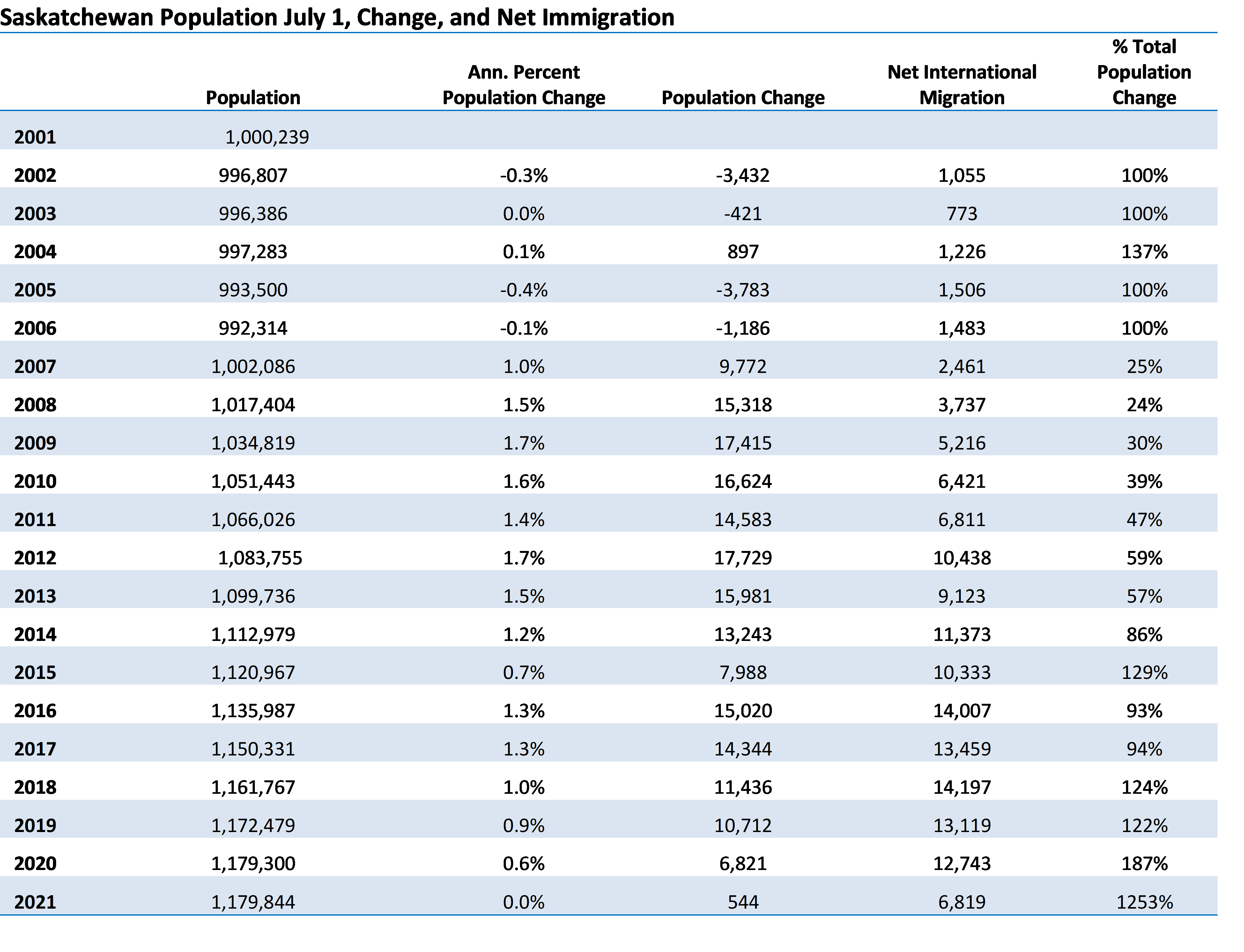
Recent Trends in Population - February 2025

Stephen Johnson
MA
Chief Economist
Recent Trends in Population
Sources of Population Growth
The mathematics of population growth are relatively simple:
Population growth = (natural increase=birth-deaths) + (migratory increase=immigration-emigration)
However, changes in the drivers of population growth changes are much more complicated. For example, at the national level the contribution of natural increase to population growth has dropped as the Canadian population aged and fertility rates declined. Currently, natural increase accounts for less than one-third of Canada's population growth and has ceased to be the major contributor to population growth. At the same time, migratory increase plays and increasing role in Canada's population growth. Migratory increase currently accounts for about two-thirds of Canada's population growth.
Definitions
Emigrant
Canadian citizen or immigrant who has left Canada to establish a residence in another country, involving a change in usual place of residence. Emigration may be either temporary or permanent.
Immigrant
An immigrant refers to a person who is or has ever been a landed immigrant (permanent resident) and who has been granted the right to live in Canada permanently by immigration authorities.
Interprovincial Migration
interprovincial migration represents all movements from one province or territory to another involving a change in usual place of residence. A person who takes up residence in another province or territory is an out-migrant with reference to the territory or region of origin and an in-migration with reference to the province or territory of destination.
Intra-provincial migration or sub-provincial migration
Intra-provincial migration or sub-provincial migration represents all movements from one region to another within the same province or territory involving a change in usual place of residence. A person who takes up residence in another region is an out-migrant with reference to the region of origin and an in-migration with reference to the region of destination.
Natural increase
Variation of the population size over a given period as a result of the difference between the numbers of births and deaths.
Net interprovincial migration Net intra-provincial migration
Net interprovincial migration represents the difference between in-migrants and out-migrants for a given province or territory.
Net intra-provincial migration
Net intra-provincial migration represents the difference between in-migrants and out-migrants in a given intra-provincial region. A region can be defined as a census division (CD), and economic region (ER), or a census metropolitan area (CMA).
Temporary emigration
Temporary emigration includes Canadian citizens and immigrants living temporarily abroad who have not maintained a usual place of residence in Canada.
Non-permanent resident
A non-permanent resident is a person who is lawfully in Canada on a temporary basis under the authority of a valid document (work permit, study permit, Ministers' permit, or refugee) issued for that person along with members of their family living with them. This group also includes individuals who seek refugee status upon or after their arrival in Canada and remain in the country pending the outcome of processes relative to their claim.
In the case of Saskatchewan, immigration has outstripped natural increase as the leading contributor of population growth since, and including, 2009. From 2016 to 2024, excluding 2021, immigration is more than double natural increase.

Removing the less important contributors to population growth and showing the results graphically below shows a more telling story:

While immigration increased rapidly up to 2020, the less important components are essentially flat or, in the case of natural increase, advancing slowly with a marked decline in 2021. Since 2002, net interprovincial migration was negative with the exception of 2007 to 2013. Driving positive net interprovincial migration during 2007 to 2013 were peak or near peak resource prices, notably oil and potash, coupled with a lack of employment opportunities in much of the rest of Canada.
Since 2001, net immigration (immigration less emigration) accounted for between 24% and 1253% of total population growth. In 2015 and 2018-2021 net immigration accounted for more than the total population change suggesting that the provinces' population would have declined in its absence.

Summary of Population Data (2001-2024)
The population data from 2001 to 2024 shows significant trends in annual percent change, net migration, and the contribution of international migration to overall population growth. The population increased by 23.9% from 1,00,307 in 2001 to 1,239,865 in 2004. The annual percent change fluctuated between -0.4% in 2005 and 2.26% in 2023. Declined occurred in 2002 (-0.3%), 2005 (-0.4%), and 2006 (-0.1%), attributed to negative population changes despite positive net migration. From 2007 onward, the population consistently grew, with notable spikes in growth during 2023 (2.62%) and 2024 (2.53%).
Migration played a critical role in population growth, especially during years of slower natural growth or decline. In later years (2018-2024), migration accounted for over 100% of total population change, peaking at 1848% in 2021, when natural growth was minimal.
From 2007 to 2010, population growth accelerated steadily (1.0-1.7%) with migration contributing around 25-39%. Between 2012 and 2016, growth remained strong (1.2-1.6%), with migration contributing increasingly to total change (57-106%). From 201802024, migration became the dominant factor in population change, exceeding natural growth contributions in most years.
The data illustrates a long-term upward trend in population growth, heavily supported by international migration, particularly during periods of slower natural growth or declines. Recent years show record-high contributions from migration as the primary driver of population change.
Implications for Business
The increasing immigrant population in Canada has significant implications for Canadian businesses, presenting both opportunities and challenges. Immigrants contribute to entrepreneurship growth, as they are more likely to start businesses than Canadian-born individuals. By 2034, immigrant entrepreneurs are projected to represent over 40% of all Canadian entrepreneurs. These businesses are often innovative, with higher rates of intellectual property ownership and investment in research and development. Immigrant-led firms also play a vital role in job creation, accounting for a substantial portion of net job growth. Sectors such as restaurants, grocery stores, and transportation have particularly high percentages of immigrant business owners, which helps drive economic activity.
Immigrant-led small and medium enterprises (SMEs) are more export-oriented than those owned by Canadian-born entrepreneurs. This contributes to the diversification of Canadian exports by opening access to global markets beyond the United States, enhancing Canada's trade performance. Additionally, immigrants address labour shortages in critical sectors such as healthcare, construction, and information technology. This is especially important given Canada's aging population and low birth rate.
However, there are challenges associated with a growing immigrant population. Rapid population growth can strain housing markets and infrastructure, potentially leading to affordability issues that may affect public support for immigration policies. Immigrant-owned businesses can often face financial constraints compared to those owned by Canadian-born entrepreneurs, including lower cash reserves and heightened sensitivity to interest rates. Skill mismatches between immigrants' qualifications and the long-term needs of the economy can also limit their integration into certain industries and reduce their economic contribution. Furthermore, immigrants tend to settle in major urban centers like Ontario and British Columbian, leading to uneven economic benefits across regions. Provinces such as those in Atlantic Canada and Quebec experience slower growth in immigrant entrepreneurship.
In conclusion, the increasing immigrant population is essential for sustaining Canada's economic growth by driving entrepreneurship, innovation ,job creation, and export diversification. However, addressing challenges such as housing shortages, financial vulnerabilities of immigrant businesses, skill mismatches, and regional disparities will be crucial to fully realizing these benefits for Canadian businesses and society as a whole.
Recent Trends in Population - February 2025
Recent Trends in Population
Sources of Population Growth
The mathematics of population growth are relatively simple:
Population growth = (natural increase=birth-deaths) + (migratory increase=immigration-emigration)
However, changes in the drivers of population growth changes are much more complicated. For example, at the national level the contribution of natural increase to population growth has dropped as the Canadian population aged and fertility rates declined. Currently, natural increase accounts for less than one-third of Canada's population growth and has ceased to be the major contributor to population growth. At the same time, migratory increase plays and increasing role in Canada's population growth. Migratory increase currently accounts for about two-thirds of Canada's population growth.
Definitions
Emigrant
Canadian citizen or immigrant who has left Canada to establish a residence in another country, involving a change in usual place of residence. Emigration may be either temporary or permanent.
Immigrant
An immigrant refers to a person who is or has ever been a landed immigrant (permanent resident) and who has been granted the right to live in Canada permanently by immigration authorities.
Interprovincial Migration
interprovincial migration represents all movements from one province or territory to another involving a change in usual place of residence. A person who takes up residence in another province or territory is an out-migrant with reference to the territory or region of origin and an in-migration with reference to the province or territory of destination.
Intra-provincial migration or sub-provincial migration
Intra-provincial migration or sub-provincial migration represents all movements from one region to another within the same province or territory involving a change in usual place of residence. A person who takes up residence in another region is an out-migrant with reference to the region of origin and an in-migration with reference to the region of destination.
Natural increase
Variation of the population size over a given period as a result of the difference between the numbers of births and deaths.
Net interprovincial migration Net intra-provincial migration
Net interprovincial migration represents the difference between in-migrants and out-migrants for a given province or territory.
Net intra-provincial migration
Net intra-provincial migration represents the difference between in-migrants and out-migrants in a given intra-provincial region. A region can be defined as a census division (CD), and economic region (ER), or a census metropolitan area (CMA).
Temporary emigration
Temporary emigration includes Canadian citizens and immigrants living temporarily abroad who have not maintained a usual place of residence in Canada.
Non-permanent resident
A non-permanent resident is a person who is lawfully in Canada on a temporary basis under the authority of a valid document (work permit, study permit, Ministers' permit, or refugee) issued for that person along with members of their family living with them. This group also includes individuals who seek refugee status upon or after their arrival in Canada and remain in the country pending the outcome of processes relative to their claim.
In the case of Saskatchewan, immigration has outstripped natural increase as the leading contributor of population growth since, and including, 2009. From 2016 to 2024, excluding 2021, immigration is more than double natural increase.

Removing the less important contributors to population growth and showing the results graphically below shows a more telling story:

While immigration increased rapidly up to 2020, the less important components are essentially flat or, in the case of natural increase, advancing slowly with a marked decline in 2021. Since 2002, net interprovincial migration was negative with the exception of 2007 to 2013. Driving positive net interprovincial migration during 2007 to 2013 were peak or near peak resource prices, notably oil and potash, coupled with a lack of employment opportunities in much of the rest of Canada.
Since 2001, net immigration (immigration less emigration) accounted for between 24% and 1253% of total population growth. In 2015 and 2018-2021 net immigration accounted for more than the total population change suggesting that the provinces' population would have declined in its absence.

Summary of Population Data (2001-2024)
The population data from 2001 to 2024 shows significant trends in annual percent change, net migration, and the contribution of international migration to overall population growth. The population increased by 23.9% from 1,00,307 in 2001 to 1,239,865 in 2004. The annual percent change fluctuated between -0.4% in 2005 and 2.26% in 2023. Declined occurred in 2002 (-0.3%), 2005 (-0.4%), and 2006 (-0.1%), attributed to negative population changes despite positive net migration. From 2007 onward, the population consistently grew, with notable spikes in growth during 2023 (2.62%) and 2024 (2.53%).
Migration played a critical role in population growth, especially during years of slower natural growth or decline. In later years (2018-2024), migration accounted for over 100% of total population change, peaking at 1848% in 2021, when natural growth was minimal.
From 2007 to 2010, population growth accelerated steadily (1.0-1.7%) with migration contributing around 25-39%. Between 2012 and 2016, growth remained strong (1.2-1.6%), with migration contributing increasingly to total change (57-106%). From 201802024, migration became the dominant factor in population change, exceeding natural growth contributions in most years.
The data illustrates a long-term upward trend in population growth, heavily supported by international migration, particularly during periods of slower natural growth or declines. Recent years show record-high contributions from migration as the primary driver of population change.
Implications for Business
The increasing immigrant population in Canada has significant implications for Canadian businesses, presenting both opportunities and challenges. Immigrants contribute to entrepreneurship growth, as they are more likely to start businesses than Canadian-born individuals. By 2034, immigrant entrepreneurs are projected to represent over 40% of all Canadian entrepreneurs. These businesses are often innovative, with higher rates of intellectual property ownership and investment in research and development. Immigrant-led firms also play a vital role in job creation, accounting for a substantial portion of net job growth. Sectors such as restaurants, grocery stores, and transportation have particularly high percentages of immigrant business owners, which helps drive economic activity.
Immigrant-led small and medium enterprises (SMEs) are more export-oriented than those owned by Canadian-born entrepreneurs. This contributes to the diversification of Canadian exports by opening access to global markets beyond the United States, enhancing Canada's trade performance. Additionally, immigrants address labour shortages in critical sectors such as healthcare, construction, and information technology. This is especially important given Canada's aging population and low birth rate.
However, there are challenges associated with a growing immigrant population. Rapid population growth can strain housing markets and infrastructure, potentially leading to affordability issues that may affect public support for immigration policies. Immigrant-owned businesses can often face financial constraints compared to those owned by Canadian-born entrepreneurs, including lower cash reserves and heightened sensitivity to interest rates. Skill mismatches between immigrants' qualifications and the long-term needs of the economy can also limit their integration into certain industries and reduce their economic contribution. Furthermore, immigrants tend to settle in major urban centers like Ontario and British Columbian, leading to uneven economic benefits across regions. Provinces such as those in Atlantic Canada and Quebec experience slower growth in immigrant entrepreneurship.
In conclusion, the increasing immigrant population is essential for sustaining Canada's economic growth by driving entrepreneurship, innovation ,job creation, and export diversification. However, addressing challenges such as housing shortages, financial vulnerabilities of immigrant businesses, skill mismatches, and regional disparities will be crucial to fully realizing these benefits for Canadian businesses and society as a whole.
This Issue's Economist:

Stephen Johnson
MA
Chief Economist
This Issue's Editor:

Spencer Boyle
BA, Economics
Project Coordinator
TrendLine Saskatchewan is published monthly by Praxis Consulting.
Want TrendLine Saskatchewan Insights Focused on Your Business?
Now Available: Sector deep dives and customized economic reports designed to inform your business decisions.